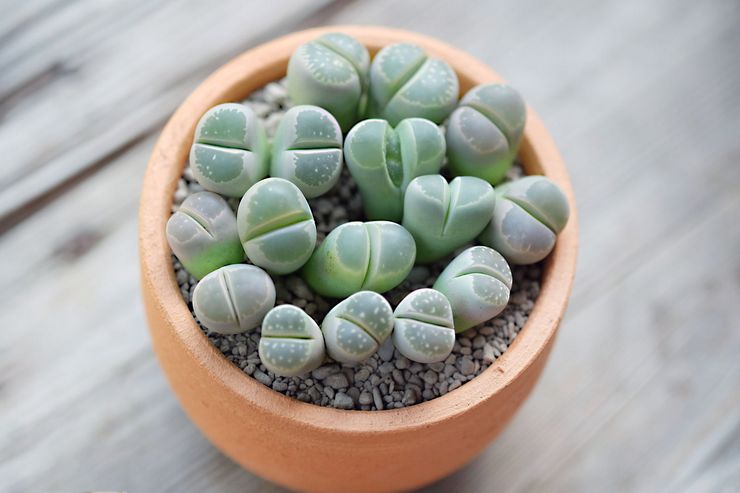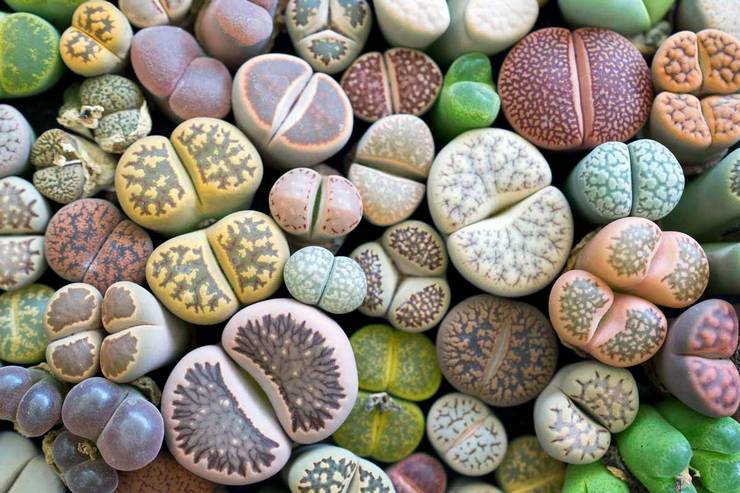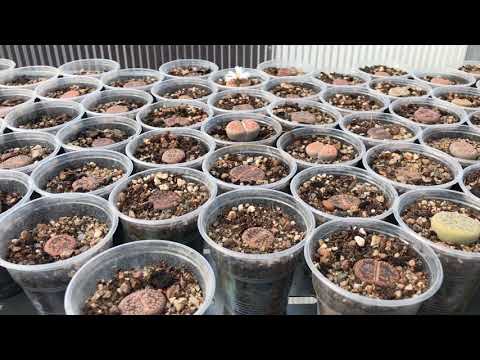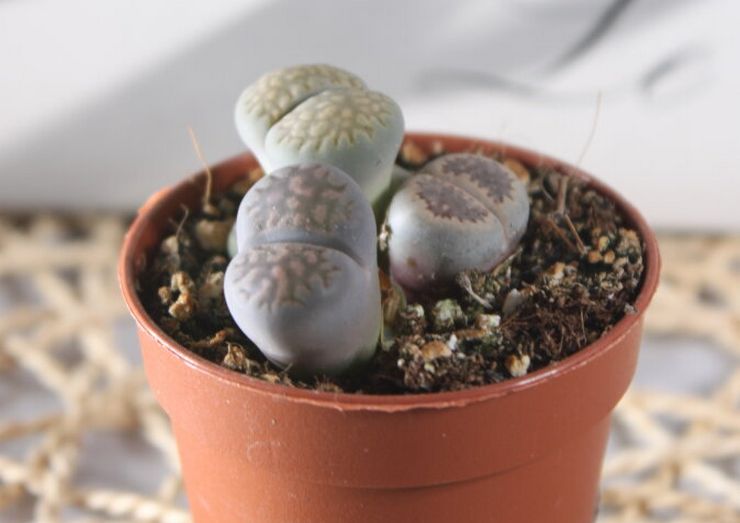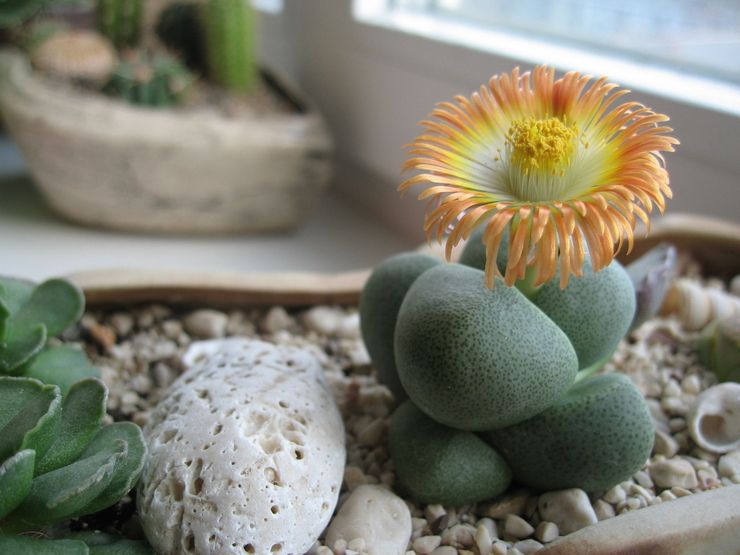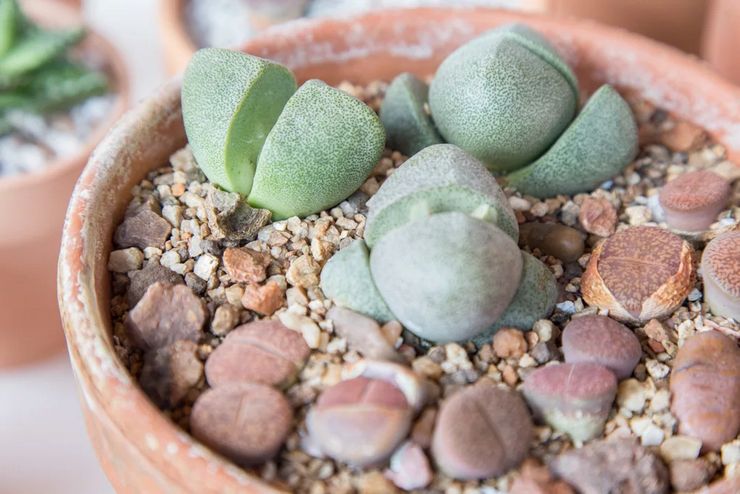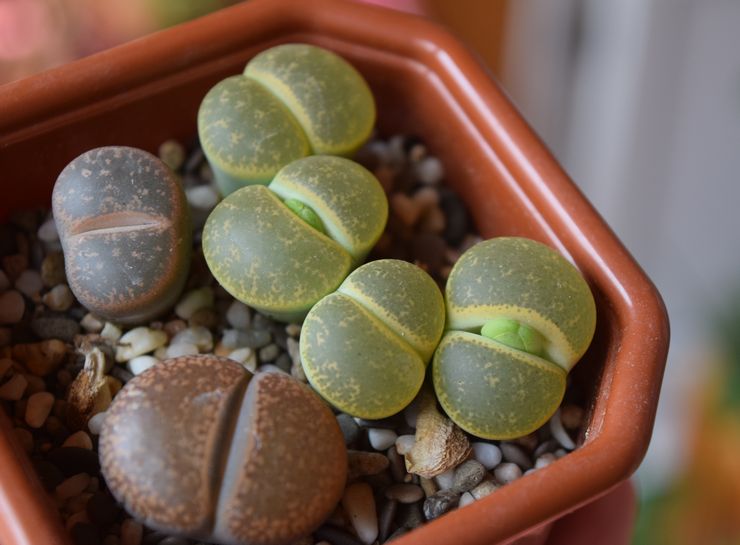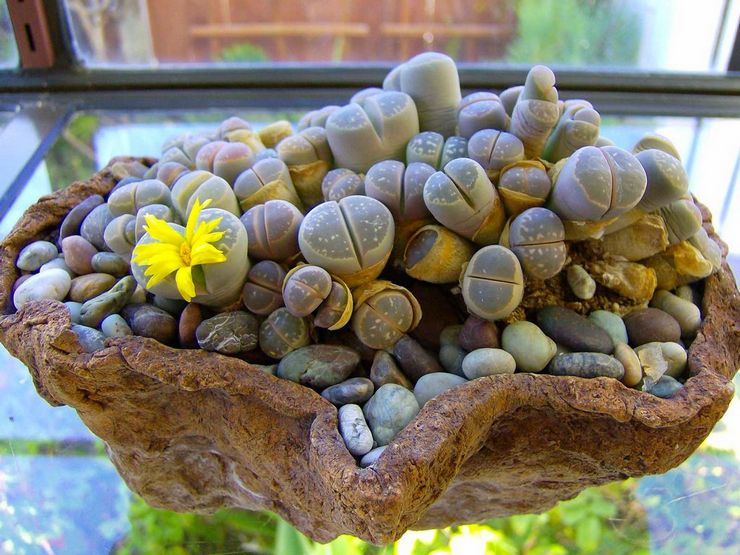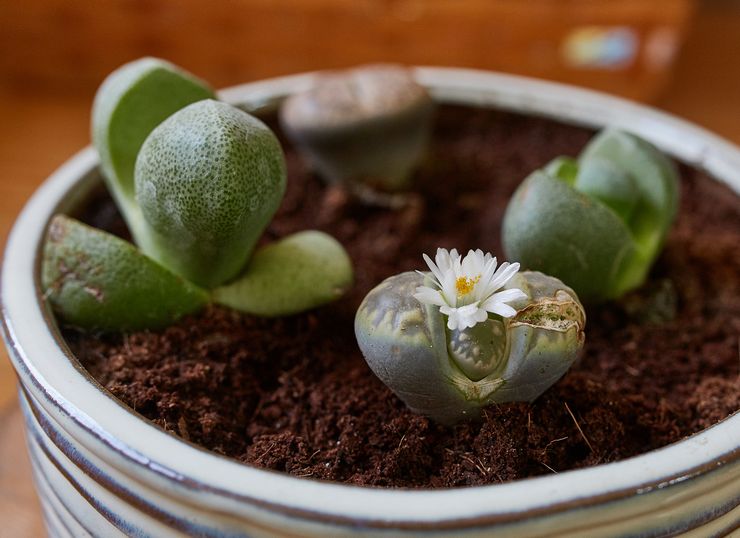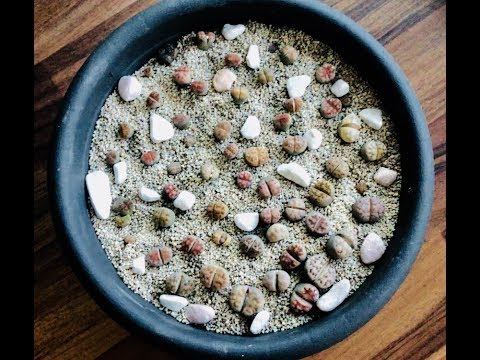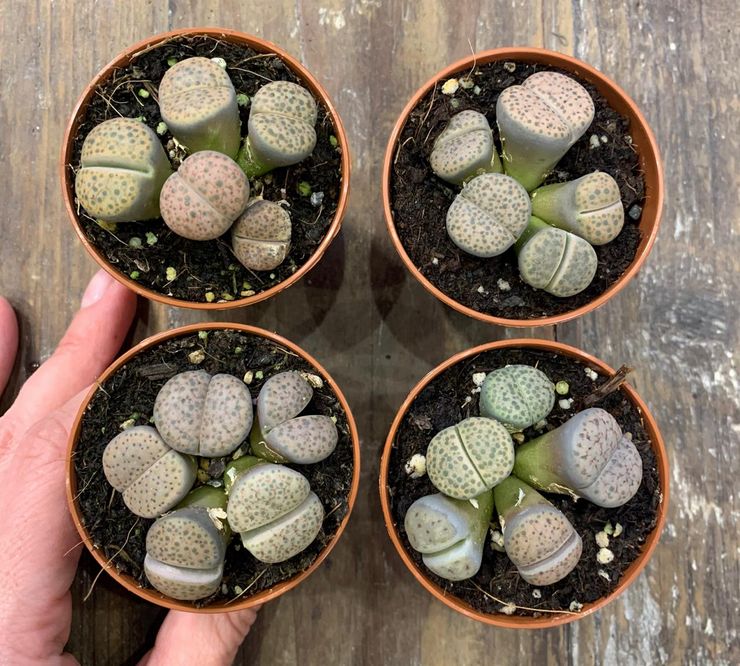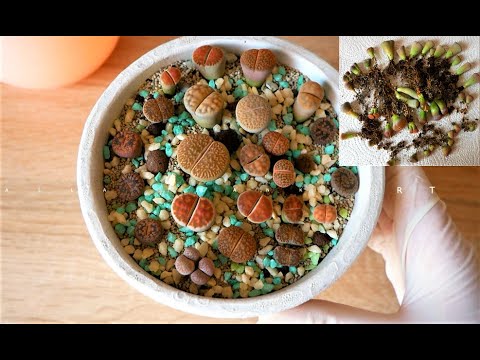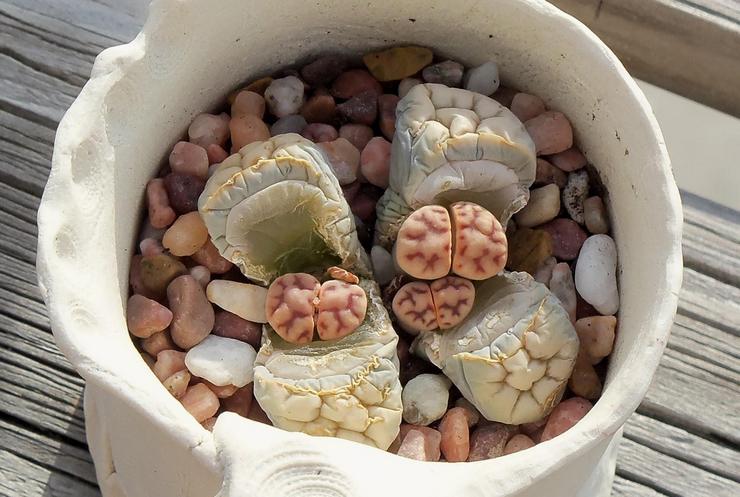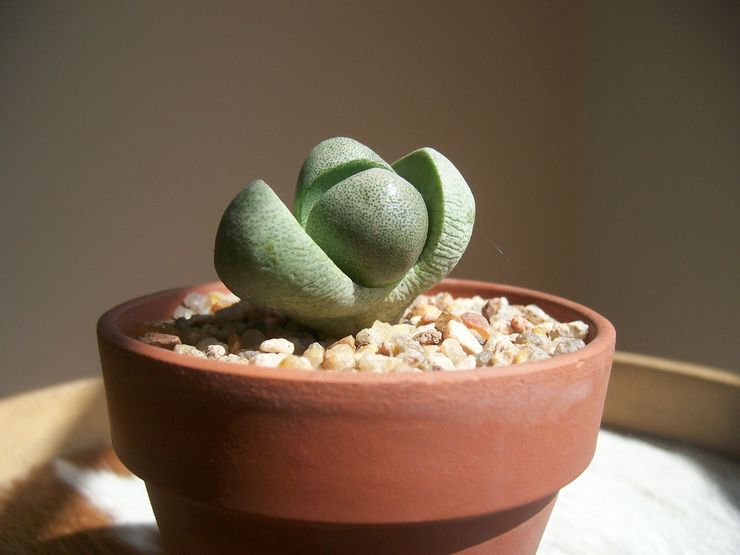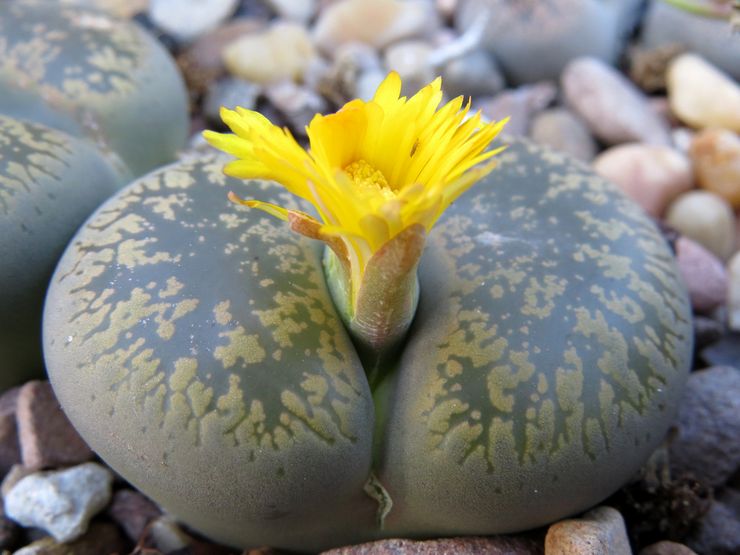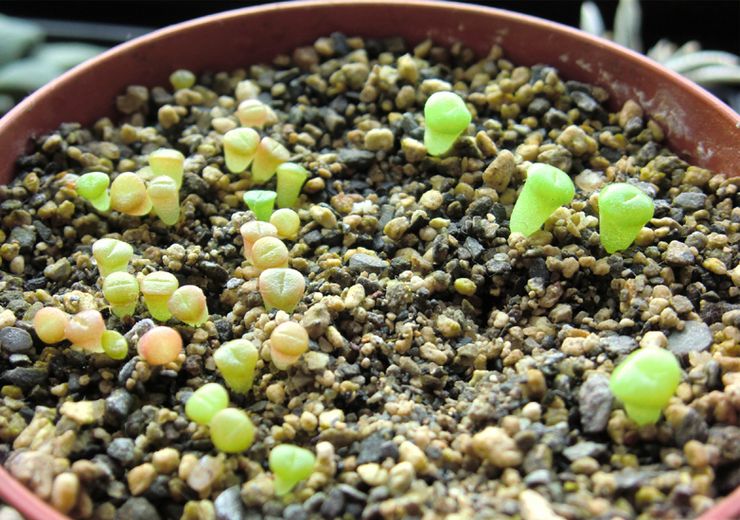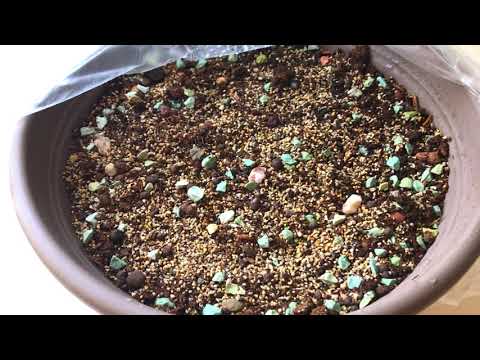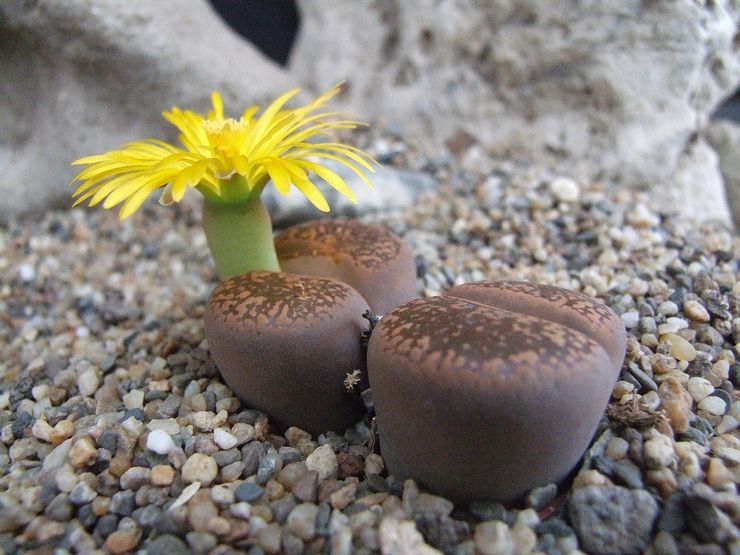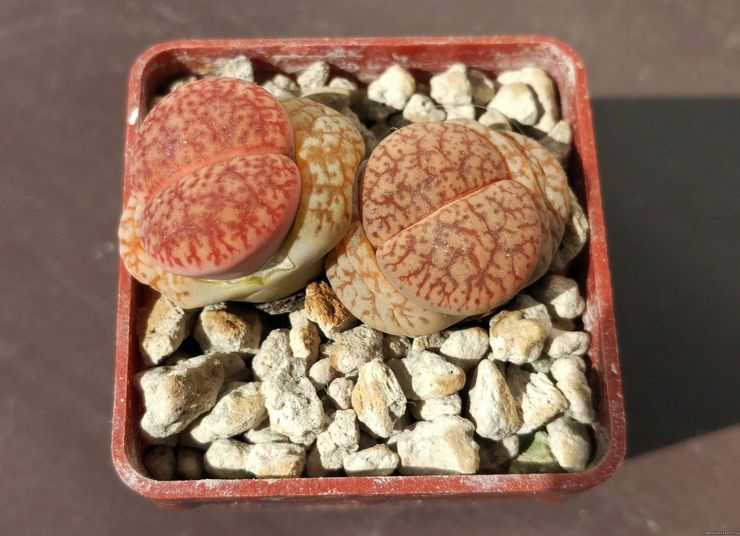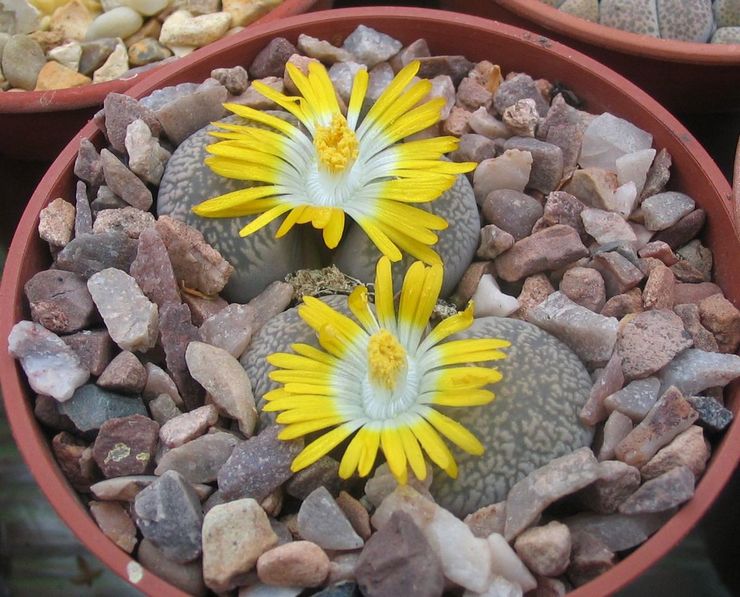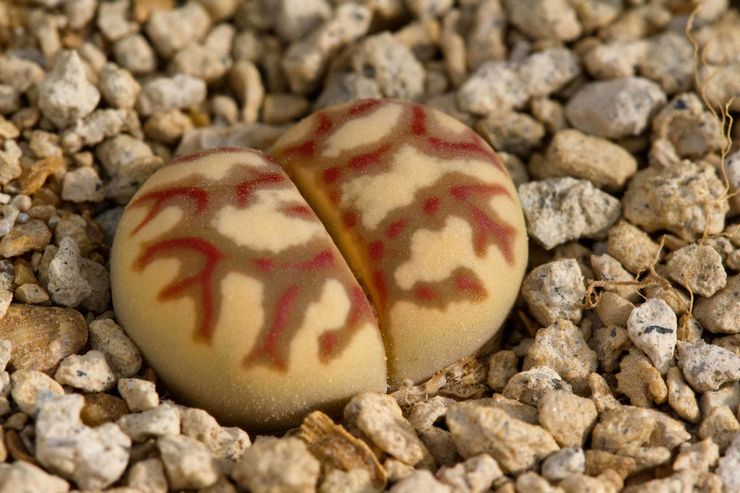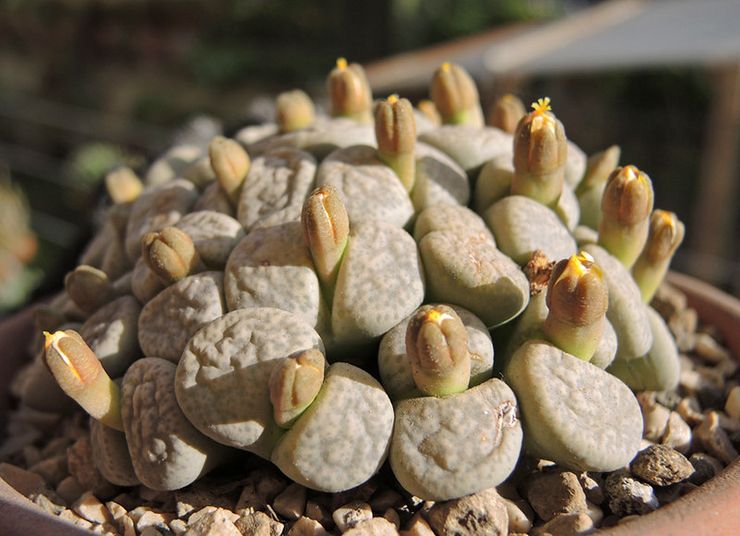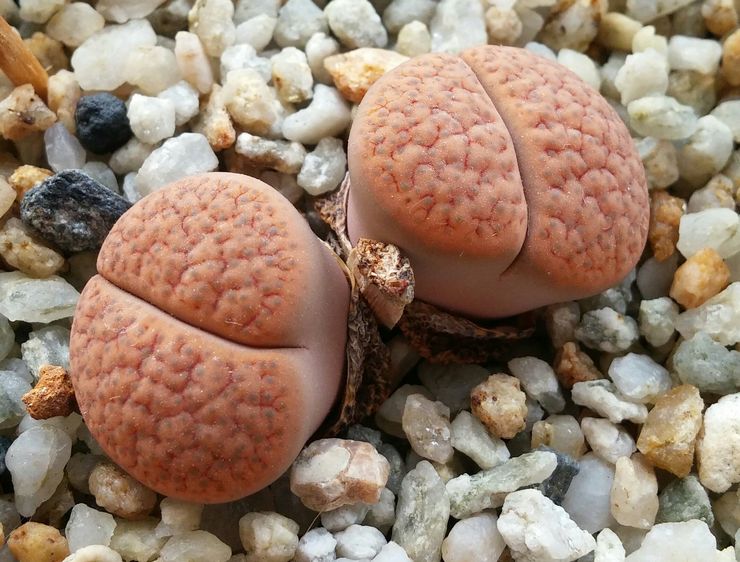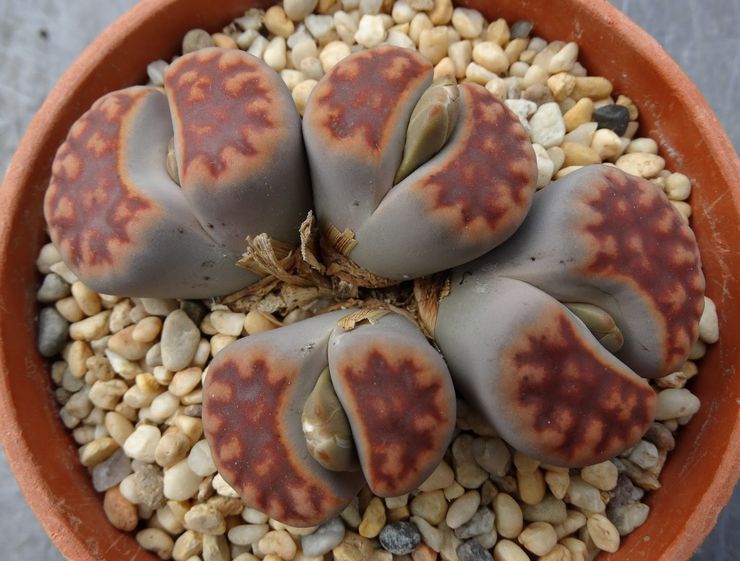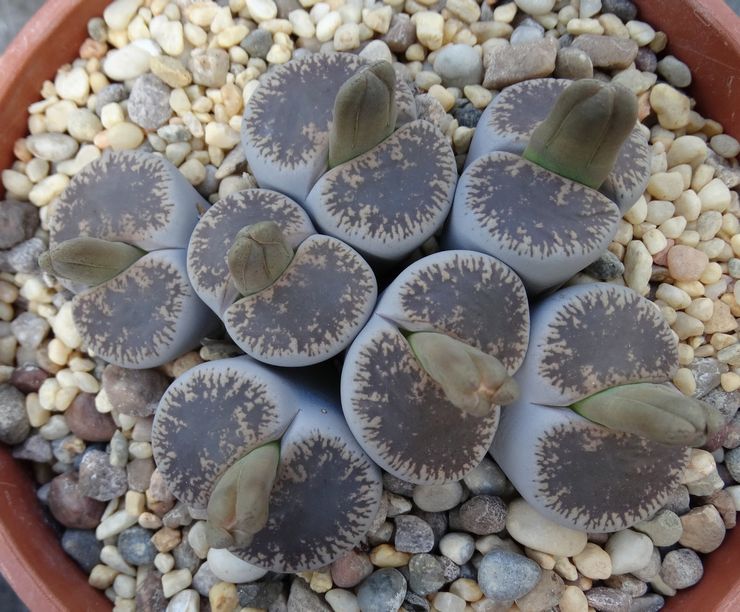The Lithops plant is a succulent known as the “living stone”. This plant belongs to the Aizov family. Translated, its name really means “like a stone.” The unusual appearance of Lithops is associated with its habitat – the South African deserts. In the natural environment, such “stones” grow on stony dry soil, literally getting lost against its background.
Description of lithops
Lithops are stemless small plants consisting of thick sheets spliced with each other, resembling pebble stones in shape and color. The succulent forms only a pair of fleshy leaves, the size of which is no more than 4-5 cm in length and width. In appearance, they resemble rounded pebbles painted in shades of gray, green, blue or burgundy. The shade of the foliage can vary depending on the growing conditions. The leaves are formed directly from the root and are almost fused at the base. They are designed to store water during periods of drought. Lithops are very similar to their related Pleiospylos and Conophytums, but still have certain differences in the structure of foliage..
The change of leaves is interesting. This does not happen often. During the “shedding” of the foliage, the old leaf shrinks and shrinks, several times decreasing in size, and a new succulent leaf grows in its place from the bottom, abundantly saturated with moisture from the inside.
From the end of summer, lithops begins a flowering period, which can last until mid-autumn. At this time, short peduncles are formed between the “pebble” leaves, on which single flowers bloom, outwardly reminiscent of chamomile. They exude a pleasant aroma and are usually yellow (rarely orange) or white. After the withering of the flowers, fruits are formed with seeds that ripen by the rainy season. After flowering, the old leaves of Lithops wrinkle, but then the bush forms fresh foliage. This process is called molting. To make the bushes look spectacular and grow faster, several plants are planted in one pot at once.
Lithops develop very slowly, reaching their maximum size only in the 10th year of rearing. The lifespan of each bush is no more than 15 years. At the same time, amazing lithops are completely undemanding in care and are well suited for beginners or busy florists. But “stones” can contain toxic substances, so plants should be removed from children and pets..
Lithops – a living stone – an unusual succulent in the collection of Georgy Aristov
Brief rules for growing lithops
The table shows brief rules for caring for lithops at home..
| Lighting level | The bright light of the southern windows will do. |
| Content temperature | In the warm season, plants are able to withstand any heat, and in winter, the room with them should be about 15-20 degrees. |
| Watering mode | In summer, watering is carried out every 1-1.5 months. In winter, lithops do not need to be watered. |
| Air humidity | Low humidity is preferred. Bushes are sensitive to high humidity and need protection from precipitation. |
| The soil | Suitable for growing universal substrates for cacti. For self-preparation, sand is mixed with clay and a small part of the garden soil. |
| Top dressing | Lithops can be fertilized only in summer, using formulations for cacti. |
| Transfer | Transplants are carried out as the plant develops. |
| Bloom | From the end of summer, the flowering period begins, which can last until mid-autumn.. |
| Dormant period | In the summer, the plant begins a dormant period.. |
| Reproduction | Seeds, leaf division. |
| Pests | Worms, sciarids and spider mites. |
| Diseases | Diseases arise from improper care. |
Lithops after purchase
If lithops was purchased at a store, such a plant will need to be transplanted into suitable soil as soon as possible. Purchased “live stones” of Dutch selection are very often planted in peat soil, which holds moisture for too long and can destroy the bushes.
Lithops are well watered, pulled out of the soil and carefully cleaned from the roots of the remnants of the earth with a thin stick or brush. After that, the roots are trying to dry slightly. For lithops, another pot is prepared with a suitable soil for it and planted in it so that the roots are neatly straightened and the taproot does not bend. The voids are filled with fresh earth, without compacting it and sprinkling the root collar. To prevent the bush from falling, you can put a small pebble next to it as a support. Sometimes the plants are buried a quarter of the height of the leaves, and the rest of their area is immersed in a drainage layer on the soil surface to prevent decay of the root collar. Watering the transplanted succulent plant only after a few days.
Lithops care at home
Lighting
Lithops loves bright lighting (about 4-5 hours of direct rays in the morning) and, with a lack of light, begins to slow down growth. Such plants can be kept in bright sunlight – on windows, balconies or light verandas in the east or southeast direction. The northern direction for lithops is not suitable, but on the southern side of the house on a sultry noon, even such an African will have to be slightly shaded from direct rays. In the afternoon, the bushes prefer partial shade.
Lithops will also need bright light in winter. To compensate for the reduction in daylight hours, the bushes are illuminated with lamps for 12 hours, which are placed about 10 cm from the “pebbles”. Young seedling plants are illuminated at a closer distance – about 5 cm.
Lithops, which are sold in stores, are usually kept in partial shade at all times. Such plants lose the habit of bright light and can get burned with a sharp change in the volume of illumination. In order not to injure the recently acquired bushes, they are taught to the direct sun in stages. The plants of the southern window, which spent the winter without supplementary lighting, should also be shaded..
Temperature
A native of deserts is not afraid of extreme heat, therefore, in the summer, he is able to perceive well even the highest (up to 50 degrees) temperatures. The optimum temperature for its development is considered to be about 25 degrees. In winter, the growth rate of lithops slows down and it can be transferred to a cooler corner, where it keeps about 15 degrees, but not below 7 degrees.
The climate of the native lithops deserts is characterized by significant temperature changes during the day, therefore, at night, the flower pot can be removed in the cool, for example, on the floor or on a colder window, but it is still not recommended to rearrange the container with the plant too often. In the warm season, lithops can be transported to the air, but “pebbles” are protected from drafts.
Watering
The soil moistening regime directly depends on the phase of development of the lithops. To do this, use soft settled water at room temperature..
The main condition for watering Lithops is to prevent moisture from entering the crevice between the leaves and onto the foliage itself. Its stagnation in this area can lead to the development of diseases. Lithops are watered carefully, so that drops do not fall on the plants, and the earth is quickly saturated and dries up properly for the next watering. Bottom watering for such plants can only be used by experienced flower growers who know how much water the plants need – otherwise the moisture may not reach the roots or the soil, on the contrary, will become waterlogged.
Leaves getting wet during watering can result in the formation of rot or burns (if the watered plant is in the bright sun). Like most succulents, lithops do not need permanently moist soil. During periods of rest or stunted growth, they are not watered at all. An exception is made when the leaves wrinkle, moistening the ground so that the soil is soaked about 1 cm deep.
For the convenience of watering lithops, you can use a baby syringe. Such a simple tool will help to gently moisturize the soil without splashing the leaves..
Humidity level
Most of the year, lithops will not need spraying – this plant prefers dry air. Moisturizing “stones” is possible only in a few cases..
- When the lithops begins to “shed” and its leaves wrinkle;
- At the end of the growing season, before lithops slows down and begins to form fresh leaves;
- In early August, bushes can be sprayed in the morning, imitating dew loss..
For the spraying procedure, a fine spray is used. Do not overdo it – the sprayed plant should dry in about an hour.
Pot selection
Lithops develop best in low but wide pots, where several (3-5) plants were planted at once. Group plantings of “pebbles” develop better than single ones, but too many specimens in one pot can make it difficult to care for them.
Planting pots that are too small or too spacious will not work. The soil in a voluminous pot will dry out longer, which can lead to hypothermia of the root system..
The soil
For growing lithops, you can use a universal cactus substrate or any neutral soil that does not contain peat. You can cook the earth yourself. To do this, sand or gravel chips are mixed with small brick debris and sheet soil in a ratio of 2: 1: 1. In the resulting mixture, add half of the clay and charcoal. You can also mix the turf soil with sand or fine gravel in equal proportions. Before planting, any soil should be sterilized, for example, by calcining it in the oven for about half an hour.
Before planting, a drainage layer must be laid on the bottom of the pot. When lithops are in a pot, the surface of the soil can be covered with small pebbles or decorative stones about 5 mm thick.
Top dressing
Lithops do not need regular feeding, especially if they are transplanted annually. Such plants should be fertilized when they have been growing in the same container for more than a year and the soil in it has begun to deplete. In this case, lithops are fed with compositions for cacti, halving the dosage recommended on the pack. Top dressing is carried out in mid-spring and late summer..
Transfer
Lithops should be transplanted only after the old pot becomes too small for it. The dimensions of the new container are calculated based on the size of the straightened roots. When transplanting, the roots can be cut a little, but if they are not damaged and healthy, it is better not to carry out this procedure.
If several lithops are planted in one common pot, a distance of about 1-1.5 cm is maintained between them. The gaps between the plants are covered with earth to close all the voids, but do not compact it. After transplantation, lithops are left without watering for several days. Such plants will begin to bloom next year, after the foliage is renewed..
LITHOPS. Transplant and Tips for Caring for Lithops
Pruning
Lithops does not need pruning – not even sanitary ones. The minimum number of leaves allows the plant to form itself from withering plates, so you should not interfere with the molting process. The bush will shed unnecessary foliage without assistance.
Wintering
During the winter months, the appearance of the lithops remains unchanged, which may make the plant appear to be resting. But it is during this period that new leaves begin to develop inside the “pebble”. All the resources of the bush will later be redirected to their development and growth.
In their homeland, Lithops finish dumping old foliage during the rainy season. Old “pebbles” crack under the pressure of drops and release the young leafy shoots that have come to replace them. Houseplants form new leaves in a short time. At the same time, only a shell remains of the old ones. During the change of foliage, care for the lithops should remain the same, but until the new leaves are completely formed, the plant cannot be watered.
Dormant period
The life cycle of a lithops includes a latent winter growing season and full summer rest. The first phase of the cycle begins in June. During this time, lithops slow down development, preparing for flowering at the end of the summer season. In nature, this feature allows plants to survive the hottest and driest times. Resting bushes are not fed or watered – moisture during this period can lead to the development of rot on the plant. It is possible to slightly moisten the soil only if the young leaves begin to wrinkle. Top dressing is also not carried out..
By the beginning of August, lithops can be sprayed in the morning, “reproducing” natural dew. From the second half of August, the second phase begins – at this time, the bushes again begin to water a little, gradually increasing in volume. This brings the lithops out of hibernation and activates its development. The crevice between the leaves begins to increase, and a peduncle gradually appears from it. In autumn, the “stones” bloom. After flowering, lithops will release new leaves directly from the diverging old ones. Young growth draws strength from them. In this case, the new pair of leaves is perpendicular to the old one. Sometimes lithops form not one, but two pairs of young leaves at once. Such a division sometimes leads to the growth of one bush into a whole colony with a common root system. After renewing the foliage, the bush begins to prepare for the winter “rest”. At the same time, watering gradually begins to reduce.
Everything about the molting of adult lithops, living stones. Most informative video.
In winter, the third phase of development begins. At this time, lithops slow down growth due to lack of light, but continue the process of changing foliage. Old plates are depleted and wither almost all autumn and winter. During this period, the bushes should be kept in a cooler place and should not be watered, fertilized or sprayed at all, but provide them with good lighting..
The fourth phase starts in the spring, when the old foliage has completely faded. These plates are not touched until completely dry. Lithops begin to water only after the old foliage is completely discarded, when it begins to resemble dry paper. Watering is gradually increasing, but by the end of spring they begin to reduce them again in anticipation of the rest of the bushes.
It is noteworthy that different species and even varieties of lithops can have their own developmental cycles. Sometimes flowering occurs not in autumn, but in mid-summer. External conditions can also affect the “schedule” – for example, the length of daylight hours. If the plant was kept under lamps in winter, its foliage can renew faster, bringing the flowering process closer..
Bloom
Lithops flowers appear in summer or autumn. They can be formed by bushes from 3-5 years old. Chamomile flowers of white or yellow color are formed on them, which stay on plants for about 2 weeks. The buds bloom by noon, when the brightness of the light begins to decrease, and close to night they close until the next day. After flowering, old lithops leaves “move away” from each other, forming young foliage in the resulting gap. In place of the flower, a fruit is formed with seeds that ripen in a few months.
Growing lithops from seeds
At home, new lithops are usually grown from seed. They can be bought or obtained by artificial pollination: pollen from one flower is transferred with a brush to another. It takes about 9 months to mature. In early spring, the resulting seeds are sown after pre-soaking. They are kept for 5-6 hours in warm water or a pale solution of potassium permanganate. After that, the seeds are spread over the surface of the moist disinfected soil and gently sprayed. It is not necessary to deepen or sprinkle them with earth. From above, the crops are covered with film or glass and placed in a warm (25-30 degrees) place, opening the shelter daily for ventilation.
Fresh seeds germinate within a week, older seeds – within a month. With the formation of sprouts, they begin to ventilate the greenhouse more often, and watering is carried out a little less often, allowing the earth to dry out slightly. Sprouts develop slowly – sometimes real foliage is formed only six months after the emergence of shoots. When the lithops seedlings grow up to 1 cm, the shelter is removed, and the soil surface near them is mulched with sand, small pebbles or expanded clay. If the seedlings fall on their side, they are lifted up with a thin stick or toothpick and lightly pressed into the soil. The first year the plants do not dive, allowing them to get stronger. In the next season, after molting, they are transplanted to a permanent place in fresh, suitable soil..
How to grow LITHOPS FROM SEEDS. The subtleties of growing LITHOPSE SEEDLINGS
Possible difficulties
Usually lithops do not cause problems for growers, but sometimes improper care can cause plant diseases or loss of their visual appeal:
- The foliage shrivels due to lack of moisture, this usually occurs during the rest period and is considered normal, but sometimes the appearance of pests, for example, spider mites, leads to wrinkling of the leaves.
- The foliage becomes smaller due to a violation of the cycle of changing leaf blades;
- Foliage swells and cracks due to excessive or frequent watering.
- The foliage is covered with brownish spots – frequent violations of the irrigation schedule.
- The pattern on the leaves fades, and they themselves become thinner and stretched – signs of a lack of lighting.
- Roots rot due to being in permanently moist soil containing peat.
- Lithops does not bloom – the soil in the pot is too fertile, the bush does not have enough light, or the care of the plant during the dormant period was improper.
Lithops can be harmed by root worms, sciarids and spider mites. They are dealt with with the help of appropriate means. During the period of winter dormancy, it often happens that the leaves of the plant are affected by the mealybug. In this case, the bush should be periodically wiped with a solution of garlic gruel, laundry soap and water until it is completely cured of the lesion..
Types of lithops with photos and names
The genus Lithops includes from 30 to 50 different species, differing in size, shape and color of leaves and flowers. At home, there are often such “stones” as:
Lithops aucampiae
The size of each leaf of Lithops aucampiae is about 3 cm. They are blue-gray and have a brownish-green top with translucent “windows”. There is a deep crevice between the foliage. Flowers up to 4 cm in diameter are colored yellow and have a faint aroma.
Lithops bromfieldii
The leaves of Lithops bromfieldii have a flat top with a contrasting marble pattern and a dull reddish-orange color. Small flowers are yellow-orange or white.
Lithops comptonii
The flower size of Lithops comptonii is considered large, the petals have a white center and bright yellow edges. The flowering of such a lithops occurs in the summer, and he rests in the winter..
Lithops dorotheae
One of the smallest species – the height of its leaves is no more than 1 cm. Lithops dorotheae resembles pebbles of quartz or spar, among which it lives. The flowers are bright yellow.
Lithops francisci
This species has fleshy and strong foliage of cream, beige or pinkish color, with one leaf slightly larger than the other in size. At the top of the foliage there are darker specks. Lithops francisci grows up to 4 cm in height and forms small yellow flowers. Due to the popularity of this plant in its homeland, it was taken under protection..
Lithops redhead (Lithops fulviceps)
The leaves of Lithops fulviceps are cylindrical and brownish with raised dark specks at the top. White or yellow flowers have a faint odor.
Lithops karassky (Lithops karasmontana)
The foliage of Lithops karasmontana is gray in color with a brownish pattern and looks like quartzite. The flowers are painted white, and the tips of their petals are pointed.
Lithops lesliei
A species that has medicinal properties, rarely found in nature. Lithops lesliei forms brown leaves with a pronounced relief at the top. The flowers are bright yellow.

